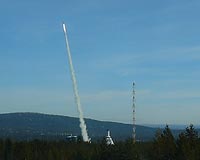 |
Bucharest, Romania (XNA) Sep 10, 2009 The Romanian Aeronautics and Cosmonautics Association (ARCA) announced on Wednesday that it will launch in October the country's first space rocket, in what is the final rehearsal for a 30 million dollar astronautic contest for landing a privately built spacecraft on the moon, initiated by the Google corporation. The rocket dubbed Helen will be launched from a Black Sea platform and is a three-stage space rocket capable of reaching the outer space in suborbital flight, ARCA president Dumitru Popescu told a press conference. During the Google Lunar X Prize Contest, it will reach the moon in three days, and during the Black Sea drill it is expected to reach cosmic space in two hours. Navy watercraft will take to Black Sea high waters the launch set consisting of rocket Helen and the balloon that is to carry it to the upper atmosphere. The equipment will be unloaded from the ships onto the sea platform, where the balloon will be inflated and the rocket stages fueled with an ecological mix of hydrogen peroxide in a 70 percent concentration. The entire set has a launch weight of over 2,000 kilograms. The rocket will be transported to the stratosphere at a 14,000-meter altitude by the world's largest solar balloon, made at ARCA. Popescu explained that once the stratosphere is reached, the ignition of the first stage engine will be initiated and will be accelerated to a supersonic speed. When the fuel of the first stage runs out, the board computer will order the initiation of the second stage, followed by stage three. This third module actually propels the payload, consisting of the European Lunar Lander (ELL) pressurized capsule. The capsule transports radio and satellite monitoring and telemetry equipment and cameras. It will be taken to the outer space by the third stage, followed by the procedure to re-enter the Earth atmosphere and the splash-down into the Black Sea by parachute deployment. Meanwhile, the carrier balloon will start the descent procedure. All system elements will be tracked by radio telemetry and telecommunication satellites. The designers of this experiment do not yet know the exact date for the rocket launch, which largely depends on weather conditions. ARCA is a non-governmental organization, national leader in aero-spatial research, and a major competitor, starting 2002, in the most prestigious space competition awarded with the Ansari X Prize. Founded in 2007, the Google Lunar X Prize competition is aimed at kicking off a rocket to the moon capable to successfully land a mobile spacecraft on the Earth's satellite, move it across 500 meters and beam home high-definition television views from the lunar surface.
Source: Xinhua News Agency Share This Article With Planet Earth
Related Links Romanian Aeronautics and Cosmonautics Association (ARCA) Rocket Science News at Space-Travel.Com
 REXUS/BEXUS Contest For Rocket And Balloon Experiments
REXUS/BEXUS Contest For Rocket And Balloon ExperimentsBonn, Germany (SPX) Sep 08, 2009 On Tuesday 1 September 2009, the German Aerospace Center announced the third contest in the REXUS/BEXUS (Rocket/Balloon EXperiment for University Students) programme. Students are invited to submit their proposals for experiments to be carried in the gondola of a stratospheric balloon in Autumn 2010 or in a high-altitude rocket in Spring 2011. The deadline for proposal submission is 16 November ... read more |
|
| The content herein, unless otherwise known to be public domain, are Copyright 1995-2009 - SpaceDaily. AFP and UPI Wire Stories are copyright Agence France-Presse and United Press International. ESA Portal Reports are copyright European Space Agency. All NASA sourced material is public domain. Additional copyrights may apply in whole or part to other bona fide parties. Advertising does not imply endorsement,agreement or approval of any opinions, statements or information provided by SpaceDaily on any Web page published or hosted by SpaceDaily. Privacy Statement |